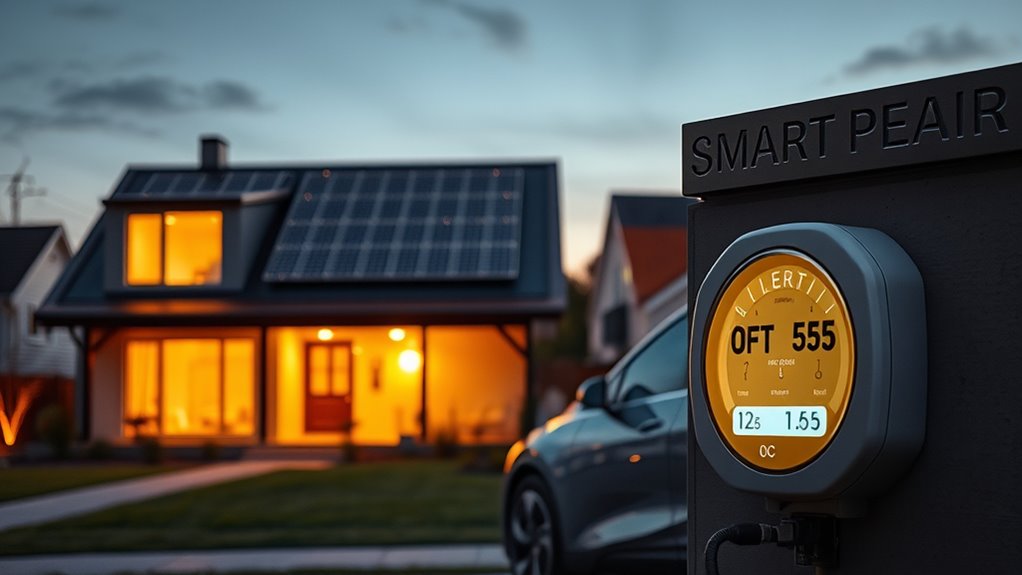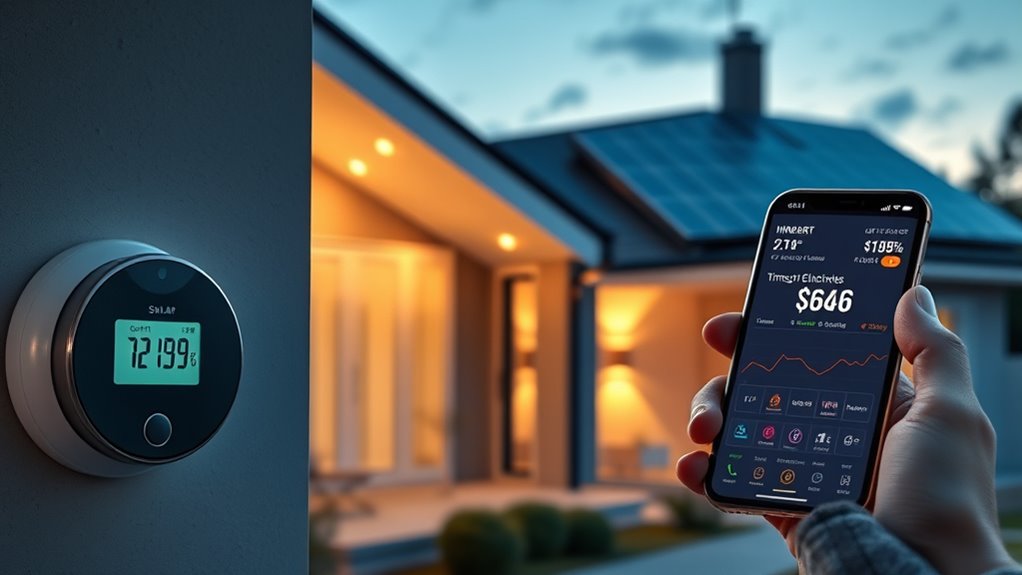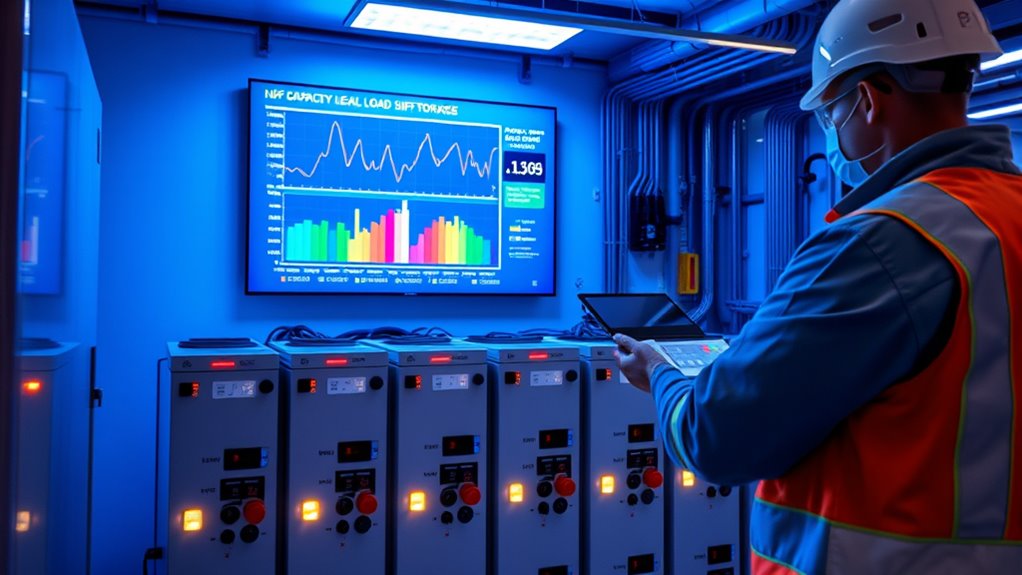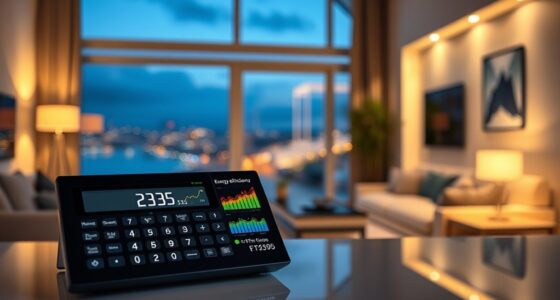Stop guessing when to use electricity by adopting advanced off-peak strategies. Use smart meters and real-time data to monitor your consumption patterns and shift high-demand activities during lower-rate periods. Incorporate time-of-use pricing and automated energy management systems to optimize your usage. Combining load shifting, battery storage, and renewable sources like solar can maximize savings and grid stability. Keep exploring these tactics to become a true energy optimization pro.
Key Takeaways
- Utilize smart meters and real-time data to monitor and shift energy consumption proactively during off-peak hours.
- Implement automated energy management systems (EMS) to optimize device operation and reduce peak demand costs.
- Leverage time-of-use pricing and demand response programs to align high-energy activities with lower-rate periods.
- Incorporate energy storage solutions like batteries and EVs to maximize savings from off-peak energy availability.
- Analyze consumption patterns and integrate renewable sources like solar to enhance efficiency and sustainability.
Understanding Off-Peak Electricity and Its Benefits

Understanding off-peak electricity is essential because it helps you save money and reduce your environmental impact. During off-peak hours, electricity demand drops, easing peak demand pressures on the grid. Utility companies often offer incentives to encourage usage during these times, making it financially beneficial for you. By shifting your energy consumption to off-peak periods, you avoid higher rates charged during peak demand hours. This not only saves you money but also supports a more stable and sustainable energy system. Utility incentives may include lower rates or rebates for using electricity during designated off-peak times. Knowing when off-peak hours occur and adjusting your usage accordingly allows you to take full advantage of these benefits, making your energy habits more efficient and eco-friendly. Modern heat pump systems with advanced energy efficiency features can further optimize your off-peak electricity use, maximizing savings and environmental benefits.
Leveraging Smart Meters and Real-Time Data

Smart meters enable you to monitor your electricity usage in real time, giving you immediate insights into when and how you’re consuming energy. With real-time data from your smart meter, you can identify patterns, optimize your energy use, and shift consumption to off-peak periods. This proactive approach helps you avoid high rates and reduce overall costs. By leveraging your smart meter, you gain control over your energy habits and can make informed decisions quickly. Utilizing vetted home theatre projectors can also enhance your energy efficiency by providing better control over your entertainment systems, further contributing to your overall energy savings.
Incorporating Time-Of-Use Pricing Into Your Strategy

Incorporating Time-Of-Use (TOU) pricing into your energy strategy allows you to capitalize on lower rates during off-peak hours by aligning your consumption accordingly. By understanding dynamic pricing signals, you can shift high-demand activities to times when electricity costs are decreased, helping you save money. This approach also helps manage peak demand, preventing costly charges during surcharge periods. Monitoring your energy use and adjusting your habits guarantees you’re not paying premium rates during busy hours. Using TOU data, you can plan to run appliances, charge electric vehicles, or operate machinery during cheaper, off-peak times. Additionally, understanding the benefits of eye patches can help you incorporate simple self-care routines that improve your overall well-being, complementing your energy-saving strategies. This strategy not only reduces your overall energy expenses but also contributes to grid stability by smoothing out peak demand fluctuations.
Using Automated Energy Management Systems

Automated Energy Management Systems (EMS) enable you to optimize your electricity usage effortlessly by controlling appliances, HVAC systems, and other devices based on real-time data. By doing so, you can considerably reduce your overall energy consumption and lower peak demand during high-cost periods. EMS helps you make smarter decisions without constant manual adjustments, ensuring your home or business runs efficiently. Incorporating cost-of-ownership math can further enhance your understanding of long-term savings.
- Adjusts device operation during off-peak hours automatically
- Provides insights into your energy consumption patterns
- Prevents unnecessary energy spikes that increase costs
With EMS, you gain better control over your energy use, minimizing waste and avoiding costly peak demand charges. This proactive approach ensures you’re always leveraging the most cost-effective times to run essential systems, maximizing savings and sustainability.
Analyzing Consumption Patterns for Optimal Timing

To effectively optimize your electricity usage during off-peak hours, you need to analyze your consumption patterns carefully. Start with peak analysis to identify when your energy demand spikes. Consumption profiling helps you understand which appliances or activities drive your usage. Tracking these details reveals hidden trends and enables precise timing for off-peak energy use. Incorporating home maintenance routines can also help reduce overall energy consumption and improve efficiency.
Integrating Renewable Energy Sources for Efficiency

Building on your understanding of consumption patterns, integrating renewable energy sources can considerably boost your efficiency and reduce reliance on the grid during peak times. Solar integration allows you to generate power on-site, decreasing your dependence on external sources. Embracing grid decentralization distributes energy production across multiple points, enhancing system resilience and efficiency. By adopting these strategies, you optimize off-peak usage and lower energy costs. Additionally, employing solar-powered attic fans can help improve home ventilation and further reduce cooling costs during hot seasons.
Integrate renewable energy and decentralize your grid to boost efficiency and cut costs during off-peak times.
These approaches empower you to harness renewable energy effectively, making your system smarter and more sustainable.
Exploring Battery Storage and Load Shifting Techniques

Battery storage allows you to save excess energy during off-peak times for later use, reducing reliance on the grid. Load shifting techniques help you move consumption to cheaper, cleaner periods, optimizing your energy costs. By understanding these methods, you can maximize efficiency and implement cost-effective strategies for your energy management. Incorporating ergonomic workspace design principles can further enhance your overall energy efficiency and comfort while working or managing energy systems.
Battery Storage Benefits
Harnessing battery storage offers a powerful way to maximize the benefits of off-peak electricity. With proper use, you can extend battery longevity while optimizing storage capacity, ensuring your system remains reliable over time. This flexibility allows you to store excess energy when rates are low and use it during peak hours, saving money and reducing reliance on the grid. Improved storage capacity means you can store more energy without needing larger systems, making it cost-effective. To get the most out of your batteries, consider factors like proper maintenance and avoiding deep discharges. When managed well, your battery system becomes an essential tool for energy independence and efficiency. Regular monitoring and maintenance are crucial to prevent issues like battery spoilage and to ensure optimal performance over the system’s lifespan.
Load Shifting Methods
Effective load shifting takes advantage of battery storage to move energy use from peak to off-peak periods. By implementing peak shaving, you reduce demand during high-cost times, lowering your energy bills and easing grid stress. Battery systems store excess energy during off-peak hours, then release it when demand spikes. This technique supports demand response programs, allowing you to adjust consumption based on utility signals, incentives, or grid conditions. Load shifting methods help smooth out consumption patterns, preventing costly peak charges. You can also integrate automation to optimize storage and discharge cycles, maximizing savings and grid stability. Additionally, understanding the meaning of consecration in the Bible can deepen your commitment to living sustainably and responsibly. Overall, these strategies empower you to manage energy more efficiently, minimize peak demand, and take full advantage of off-peak rates.
Cost Optimization Strategies
To truly optimize costs, integrating advanced load shifting techniques with battery storage offers a powerful solution. By leveraging battery systems, you can store excess energy during off-peak times and use it during peak periods, reducing demand charges. Incorporating demand response programs allows you to adjust consumption based on grid signals, further lowering expenses. An electric vehicle (EV) can also serve as a mobile energy storage device, providing additional flexibility. Proper handling of raw materials, such as raw chicken, is essential to prevent food safety issues and ensure a safe energy management system.
Monitoring and Adjusting Strategies With Data Analytics

Data analytics plays a crucial role in fine-tuning your off-peak electricity strategies by providing real-time insights into consumption patterns and grid performance. With accurate demand forecasting, you can predict when energy needs will surge or drop, allowing you to adjust your usage accordingly. Monitoring tools help you identify deviations from your plan, so you can respond swiftly. Additionally, analyzing pricing models reveals how fluctuating rates impact your costs, enabling you to optimize your consumption during the most economical periods. By continuously collecting and evaluating data, you stay informed about performance trends and can make informed adjustments. This proactive approach ensures your off-peak strategies remain effective, maximizing savings while maintaining reliable energy use.
Future Trends in Off-Peak Electricity Optimization

Emerging technologies and evolving grid management practices are shaping the future of off-peak electricity optimization. As grid modernization accelerates, you’ll see smarter infrastructure that predicts demand patterns and adjusts supply accordingly. Policy regulations are becoming more supportive, encouraging renewable integration and flexible consumption. These changes will enable you to leverage real-time data and automation for more precise energy use.
- Increased adoption of smart meters and IoT devices enhances your ability to monitor and control consumption.
- Regulatory frameworks will incentivize off-peak usage, making strategies more accessible and cost-effective.
- Advanced AI algorithms will optimize grid performance, reducing waste and lowering costs for consumers and providers alike.
Frequently Asked Questions
How Do Off-Peak Rates Vary by Region and Provider?
You’ll find that off-peak rates vary by region and provider, with some areas offering markedly lower prices during off-peak hours. Regional differences influence pricing due to local energy generation and demand patterns, while provider variations stem from their pricing plans and incentives. To save money, compare regional rates and explore different providers’ off-peak plans, ensuring you choose the most cost-effective options tailored to your area’s specific off-peak electricity rates.
What Are Common Mistakes When Implementing Energy Automation Systems?
Imagine building a house without a blueprint—that’s what misconfigured sensors and inaccurate forecasts can feel like in your energy automation system. You might set it to save energy, but misconfigured sensors send false signals, causing wasted power. Inaccurate forecasts lead to poor planning, leaving your system underperforming. Always double-check sensor setups and rely on precise data to keep your automation running smoothly and efficiently.
How Can I Estimate Savings Before Adopting New Strategies?
You can estimate savings by analyzing your current energy consumption and conducting a thorough cost analysis of potential strategies. Start by reviewing past utility bills to identify usage patterns, then simulate how the new approach might reduce consumption during off-peak hours. This way, you’ll have a clear projection of potential savings, allowing you to make informed decisions before fully implementing the strategies and minimizing risks.
Are There Legal or Regulatory Concerns With Load Shifting?
Yes, there can be legal restrictions or regulatory compliance issues with load shifting. You need to check local laws and utility regulations because some areas have rules that limit when and how you can shift load. confirm your strategies align with legal standards to avoid penalties. Consulting with regulatory agencies or legal experts helps you stay compliant, so you can optimize your off-peak electricity use without legal concerns.
What Are the Best Tools for Comparing Off-Peak Electricity Plans?
Like a seasoned navigator consulting the stars, you’ll want reliable tools for energy comparison and plan evaluation. Use platforms like ChooseEnergy, PowerToChoose, or EnergySage to compare off-peak electricity plans efficiently. These tools provide detailed data on rates, peak/off-peak hours, and contract terms, helping you make informed decisions. By leveraging these resources, you guarantee your load shifting strategies are cost-effective and aligned with your energy goals.
Conclusion
By mastering these advanced off-peak strategies, you’re tuning your energy usage like a maestro conducts a symphony, turning data into harmony. With smart tools and insightful timing, you’ll transform your electricity habits from guesswork into precision art. Embrace these techniques, and watch your efficiency blossom like a well-tended garden, ensuring your energy landscape is both sustainable and beautifully orchestrated for the future.









